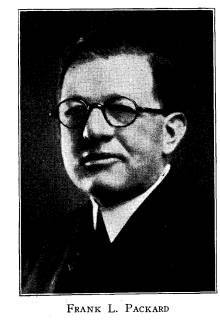Ohio History Journal
|
106 Ohio Arch. and Hist. Society Publications FRANK L. PACKARD The announcement of the sudden death of Frank L. Packard on Friday morning, October 26, brought sadness to a wide circle of friends in Ohio and other states. In Columbus where he was personally known as almost no other citizen, the expressions of regret were general and sincere. The Ohio State Archaeological and Historical Society, of which he had been a trustee
Reviews, Notes and Comments 107 neer of Delaware. Later he took special
courses in architecture and engineering at the
Ohio State Univer- sity and the Massachusetts Institute of
Technology. He also studied in the offices of the
leading architects of New York City. In 1892 he came to Columbus, formed a
partner- ship with J. W. Yost and entered upon
the practice of his profession. In 1899 he acquired full interest in the firm. The list of buildings that he
planned is a long one.
The first big structure for which his plan was accepted on competition was the Girls'
Industrial Home near Delaware. Following this his plans were ac- cepted for other state buildings. A number of these are on the University grounds of the
capital city and the grounds of the other state
universities. His plans were accepted for the Lima State
Hospital for the Criminal Insane, one of the largest
structures of its kind in the world. Recently he was
selected by Presi- dent Harding to plan and superintend
the construction of the American Embassy building at Rio
Janeiro, Brazil, which was formally dedicated
last summer at the Brazilian Exposition. The papers announce that all told he had designed more than 3400
buildings. He was prominent in business and civic circles
in Colum- bus and was active officially in the
affairs of the Broad Street Presbyterian Church. In 1892 he was married to Eva L. Elliott, of Delaware, who
survives him. Edi- torially the Ohio State Journal pays
Mr. Packard this tribute: Mr. Packard was a great architect. He
was a great citizen, too. In these later years his time was
in constant demand but he always had it to spare for his city.
Anything, at any sacri- fice of his personal interests, which he
felt he could do for 108
Ohio Arch. and Hist. Society Publications Columbus, was done with generous
enthusiasm. To him more than to any other man Columbus owes the
fact that the dream of a Civic Center is becoming a reality.
That noble idea, in its concrete form at least, was Mr.
Packard's and many hours and days and weeks he gave to perfecting his
plans and to helping create an irresistible sentiment for
this greatest of city beauti- fications, this building for the future
of Columbus. What a monument this will be to a great
architect and a great citizen. PROFESSOR CHARLES SUMNER PLUMB. Professor Charles Sumner Plumb, author
of the leading contribution to this issue of
the QUARTERLY, was born in Westfield, Massachusetts,
April 21, 1860. He was graduated from the Massachusetts
Agricultural College at Amherst. For a time he was
engaged in editorial and agricultural experiment
work. Since September 1, 1892, he has been
professor of animal husbandry in the Ohio State
University. He is author of the following works: Biographical
Directory of American Agricultural Scientists;
Indian Corn; Little Sketches of Famous Beef
Cattle; Types and Breeds of Farm Animals and revision of same; A Par- tial Index to Animal Husbandry
Literature; Beginnings of Animal Husbandry; Judging Farm
Animals; also many monographs and contributions to
agricultural periodicals. Of his Types and Breeds
of Farm Animals more than 100,000 copies have been
sold. Professor Plumb has for years been a
recognized authority in his field and his
monograph in this issue of the QUARTERLY is a tribute to one of
Ohio's pioneers and a distinct contribution to the
history of the live stock industry of the state. |
